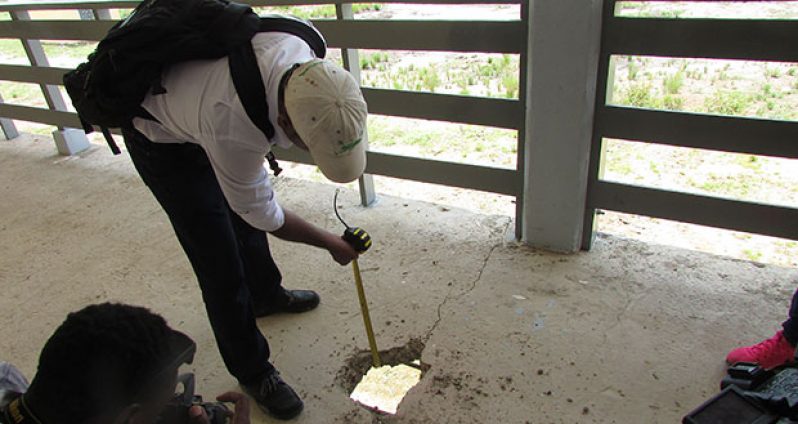–President says legal measures to recover cost for poor work on Kato Secondary
“People feel that once you are dealing with the hinterland that nobody will go there to check. “Those were the sentiments of President David Granger when questioned on Thursday on the weekly televised programme, The Public’s Interest, about the defective Kato Secondary School.
According to the President, the school in its present state is unsafe for children and the Government will examine what legal measures can be put in place to recover the excess expenditure from the contractor, Kares Engineering.
And he said pointedly, that the construction firm will not receive any contracts from Government in the future.
The Guyana Chronicle last week reported that remedial works to the Region Eight school could cost more than $140M.This is according to representatives of the auditing company Rodrigues Architects Limited.
Kares Engineering was contracted to build the school at a cost of $728M. According to the Ministry of Public Infrastructure, it is estimated that 60 per cent of the school is defective. President Granger noted on Thursday that the defective building is an indication of the challenges the present administration faces.
He said prior to the 2015 General Elections “there was a big rush to finish projects at any cost” to indicate what the Government of the day was doing. But things are different now, he said, noting that bad roads, buildings, stellings and bridges including the defective Hope Bridge on the East Coast of Demerara are some of the challenges facing the administration.
Turning his attention back to the school at Kato, the President noted, “it is quite clear the works were substandard, it’s unsafe to put children in that building.”
The Government is now faced with the task of correcting the faults, and the President said that it is a burden that the administration will have to shoulder.
“We are concerned with education, we want to see children in school,” he said, noting that the Government will correct the faults in the building to ensure it is safe and that the children who attend the school could have access to education as others in any other part of the country.
While the President has not been advised on a new building to house the students, the Ministry of Public Infrastructure had undertaken a complete examination of the building.
According to Managing-Director of Rodrigues Architects Limited, Albert Rodrigues, the school has “countless” structural defects. These flaws were highlighted in both the draft and final report of the project submitted to the Ministry of Public Infrastructure by the company.
In the report, a number of issues were highlighted, ranging from the prioritising of cost effectiveness over professional competence to the use of inadequately qualified consultants for the project.
Additionally, countless flaws on the physical structure of the school were pointed out by architect Davendra Doodnauth of Rodrigues Architects. Amongst the areas highlighted were bad timbers, exposed electrical outlets, cracking stairways and exposed steel.
“How could any self-respecting contractor accept work like this?” Rodrigues questioned, while pointing to another defect.
The Toshao of Kato reported that residents were anxious for the school’s opening but soon became disappointed upon learning of all the defects.
He said that the situation at the neighbouring Paramakatoi Secondary School, where students were re-assigned, has become untenable due to overcrowding. As a result, students are forced to attend schools as far away as Sand Creek, Region Nine, due to the lack of available facilities.
Works on the Kato Secondary School commenced in 2013. The Government Information Agency (GINA) said at the time that the facility when completed will cater for approximately 350 students.
The scope of work for the project included 12 classrooms, an industrial arts department, a canteen, two science laboratories, an administrative block, a computer laboratory, home economics and agriculture departments, facilities for differently-abled persons, sanitary blocks, two multi-purpose rooms, a library and research area, and a visual arts department.
A dormitory to accommodate 300 students coming from other villages and satellite communities, was also constructed. A dining area, lobby, sleeping area, laundry room, accommodation for dorm wardens, kitchen, and sanitary facilities were included in the scope of works, it was reported at the time.




.png)









